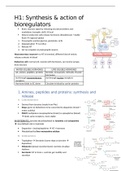H1: Synthesis & action of
bioregulators
Brain: neurons signal by releasing neurotransmitters and -
modulators (synaptic cleft) local
(Neuro) endocrine cells release hormones (bloodstream + bodily
fluid) regional/ global
1. Presynaptic vesicles (glycine, glutamate, Ach)
2. Depolarisation Ca-influx
3. Release NT
4. Act on receptors in postsynaptic neuron
Neurosecretory neurons= no NT in terminal, different kind of vesicle,
release contents in blood
Endocrine cell= normal cell, vesicles with hormones, can receive synaps
from neurons
WATER-SOLUBLE HORMONES LIPID-SOLUBLE HORMONES
AA, amines, peptides, proteins Steroids, eicosanoids, retinoids, thyroid
hormones
Act through transmembrane Act through nuclear receptors
receptors
Hormone binds to EC dome Circulate in blood by carrier proteins
1. Amines, peptides and proteins: synthesis and
release
A. Catecholamines
Derived from tyrosine (made from Phe)
Dopa: given to Alzheimers to be converted to dopamine (mood +
motor activity)
PNMT methylates norepinephrine (brain) to epinephrine (blood)
binds same receptors, more stable
INVERTEBRATES: tyrosine decarboxylated to tyramine and octopamine
less defined role in mammals
Dopamine + (nor)epinephrine NT + hormone
Metabolised by liver monoamine oxidase
B. Indoleamines
Tryptophan Serotonin (same steps as tyrosine
dopamine)
Melatonin (pineal neurohormone) controls circadian
rhythms
Serotonin: NT in brain + controls gut motility and
secretion
1
, 1.1 STORAGE AND RELEASE OF AMINES
1. Amines loaded in vesicles by monoamine
vesicular transporter
2. Vesicle docks on plasma membrane
3. Ca triggers vesicle fusion release amine by
exocytosis
4. Recycling of vesicle
Short time regulator: Ca release
Long time regulator: synthesis
WHAT MONOAMINES THEY HAVE DEPENDS ON THE
ENZYMES THEY CONTAIN
1.2 SYNTHESIS OF PEPTIDE HORMONES
1. Gene transcription in nucleus
2. Translation to preprohormone on ribosomes in RER
3. Signal peptide attaches to RER membrane + cleaved off prohormone packaged in vesicles
4. Vesicles translocate to Golgi formation storage granules (dense core vesicles)
Processing prohormone in RER, Golgi, storage granules
One hormone can have multiple copies different parts with different actions
Proteolysis of prohormone in secretory pathway mature hormone
2. Amines, peptides and proteins: receptors and
signaling
2.1 RECEPTORS FOR AMINE AND PEPTIDE BIOREGULATORS
1. Receptors in cell membrane ligand binding
2. Signal transduction via second messengers (Ca, cAMP): acute + long-term effects
3. Cellular responses + changes in gene expression (nucleus)
Cells with ligand-specific receptors can react to hormone
Different receptor types exist for same hormone (α- and β-adrenergic receptors)
Receptor type different IC transduction pathways
Receptor kinases G-protein coupled receptor
1 TMS 7 TMS
GH, IGF, insulin Glucagon, hypothalamic hormones, pituitary
hormones, (nor)epinephrine, dopamine
Loop between TM5 and TM6: conformation
change upon binding interacts with trimeric
G protein
A. Receptor tyrosine kinases (RTK)
1. Binding of epidermal growth factor (EGF) to receptor
2
, 2. Dimerization
3. Autophosphorylation
4. Interaction with effectors + phosphorylation of
effectors
B. Ras/MAP kinase cascade
DOWNSTREAM OF RTKs!!
1. Ligand binds to RTK dimerization
2. Autophosphorylation interaction with adaptor protein Sos
3. Activation RAS: exchanges GTP for GDP
4. Activation Raf: start kinase cascade
5. MAPK phosphorylates TF gene expression
C. 1 TMS receptors interacti ng with JAK-STAT
pathway
1. Ligand binding dimerization
2. Attraction of JAK kinase
3. Phosphorylation of JAK and receptor
4. Phosphorylation of STAT TF nucleus
D. TGF- β pathway uses a Ser/Thr kinase
receptor
1. Ligand binding dimerization
2. Autophosphorylation
3. Phosphorylation of SMAD
4. Regulation of transcription
E. 1 TMS receptors with membrane-bound
guanylyl cyclase
1. Activated receptor guanylyl cyclase production cGMP from GTP
2. Activation ion channels (retina) + protein kinase G (kidney)
CGMP IS SHORTLIVED SMALL MOLECULE, LOW CONC IN CELL
SOLUBLE GUANYLYL CYCLASES ACTIVATED BY NO (VASODILATION)!
F. G protein signaling pathways
1. Trimeric G-protein: α,β,γ-subunits lipid tail of γ associates with PM
2. Stimulation receptor α dissociates + exchanges GTP for GDP
3. Activated α interacts with downstream effectors:
- Gq: stimulates phospholipase C IP3 (release Ca from intracellular stores)+ DAG
(activation protein kinase C)
- GS: stimulates adenylyl cyclase formation cAMP
- Gi: inhibits adenylyl cyclase
3
, DEPENDING ON WHICH RECEPTOR A CELL HAS,
THE GS or Gq PATHWAY IS PRODUCED!
Amplification of the hormonal signal gain of
the signal can be regulated!
2.2 TURNING OFF THE RESPONSE TO GPCR
ACTIVATION
a) Endocytosis of ligand-receptor complex fewer receptors at cell surface
b) Phosphorylation of receptor inactivation
c) Degradation of 2nd messengers (cAMP) short halve lives, require continuous production
d) Extracellular ligand degradation terminates signal
3. Lipid bioregulators
Fat-soluble: cross PM + bind nuclear receptors (shuttle between cytoplasm and nucleus)
Circulation in body fluids: binding to carrier proteins
PRODUCED DE NOVO (EXCEPT THYROID HORMONES)!
3.1 SYNTHESIS OF STEROIDS AND LIPID HORMONES
In mitochondria + SER
Produced enzymatically from acetyl-CoA
No storage: rate of production controls rate of release
Cholesterol: synthesised endogenously from mevalonate +
obtained from diet (as LDL in blood)
Cholesterol: complex ring structure with 27 C
1) 21-hydroxylase, 11β-hydroxylase: converts progesterones to corticosteroids
2) 18-hydroxylase: convert CC to MC
3) 17-desmolase: converts progesterones to androgens
4) P450 aromatase: converts androgens to estrogens
3.2 STEROID TRANSPORT
Non-soluble in blood
Different steroid hormones use distinct plasma-binding proteins: corticosteroid binding
globulin + sex hormone binding globulin
4




